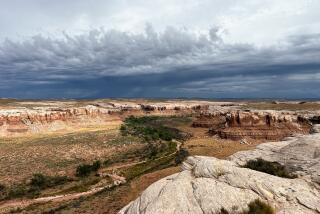Not a Pretty Sight
- Share via
On July 12, 1984, President Reagan went to Bowling Green, Ky., to proclaim that his Administration had saved the national park system from the neglect of his predecessors. But take a look at what has happened to the parks since then.
The Kentucky trip was the election-year culmination of the Ronald Reagan-James G. Watt charade that prior Presidents and secretaries of the interior had permitted the parks to deteriorate disgracefully and that this Administration had ridden to the rescue of parks and the environment.
There was just enough fact in Reagan’s claims to make them believable to the unwary. Reagan and Watt had trumpeted the four-year, $1.1-billion Park Restoration and Improvement Program, which was completed in 1985, as a park-saving effort. But the program had little to do with the protection of natural park resources, dealing rather with visitor-use facilities like roads, bridges, buildings and water and sewer systems.
Such facilities are important. Previous Congresses and Administrations had been stingy with the National Park Service budget. But concrete and blacktop are not adequate yardsticks by which to measure an Administration’s commitment to the environment. Even by those measures, however, it now is the Reagan Administration that has allowed park facilities to fall into disrepair and neglect.
A painstaking study by the General Accounting Office, the congressional investigatory agency, has disclosed that the National Park Service is running nearly $2 billion behind in maintenance and repair programs. The Federal Highway Administration rated half the park system’s roads as poor, and getting worse. Historic buildings literally are falling down. Even if maintenance funds were available, many parks do not have the staffs to do the work. Without an infusion of new money, some park assets will be lost permanently.
The biggest backlogs occur in some of the large Western parks that Reagan and Watt had proclaimed as the “crown jewels” of the system--including Yellowstone, Glacier, Grand Teton and Yosemite. The shortfall at Yellowstone alone was listed at $361 million.
Park Service Director William Penn Mott disagreed sharply with the GAO report, and claims that the parks are in better condition than they were 10 years ago. Few others concur. In a 407-page report issued in 1985 after an exhaustive study, the Conservation Foundation said: “The cumulative impacts of heavy visitor use and deferred maintenance of resources, together with threats posed from activities originating outside park boundaries, will seriously damage the parks unless checked, at least in part, by an infusion of fix-up funds and by new, imaginative responses.”
The President’s Commission on Americans Outdoors proposed a $1-billion-a-year trust fund for parkland acquisition and support, citing a need to protect and improve the federal estate. Members of Congress are pursuing the commission’s suggestions with legislation, but the Administration has suppressed its own commission’s report.
The budget deficit is no excuse for allowing the nation’s parks to become ragtag and trashy, as so many of them are. The people have always been willing to support an excellent national park system. The parks provide a mirror by which the nation can measure its pride in itself and in its natural wonders. Alas, the reflection that one sees these days is not a pretty picture.
More to Read
Sign up for The Wild
We’ll help you find the best places to hike, bike and run, as well as the perfect silent spots for meditation and yoga.
You may occasionally receive promotional content from the Los Angeles Times.






